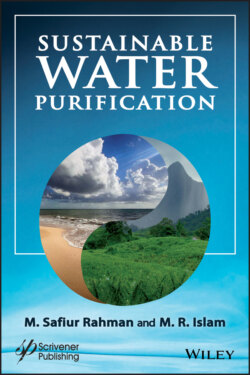Читать книгу Sustainable Water Purification - M. R. Islam - Страница 13
1.2 Climate-Water-Food Nexus
ОглавлениеClimate-Water-Food nexus epitomizes current civilization that depends on energy as the driver. As such it is one of the most popular themes used in both sustainability and climate change research (Hellegers et al., 2008; Bazilian et al., 2011). Table 1.2 shows key elements of the water component of the nexus.
The primary energy source of the Earth is the sun. The sunlight is essential to photosynthesis that requires CO2 and water as well as the presence of a plant biomass. As such, CO2 is integral to the Energy-Water-Food nexus (Figure 1.2). In this process, any pollutant added to the process that produces CO2 can alter the quality of food, which then can alter the entire water cycle, thus forming a ‘spiraling down’ mode in the overall ecosystem. In an agricultural process, any artificial chemical added to the water or soil system will affect the quality of food. Equally impactful is the overall composition of the atmosphere and the temperature, because each of the oxidation reactions is a sensitive function of temperature and composition. Even a small amount of toxins can alter the natural pathway irreversibly through catalytic actions. In connection with environmental resource management, the term nexus was introduced for the first time during the 1980s, notably in a project by the UN University (Food-Energy Nexus programme, as pointed out by Sachs and Silk, 1990). However, the Nexus Approach only gained prominence in international academia and policy circles in the lead-up to the Bonn Conference (2011) on the “Water, Energy and Food Security Nexus”. The well-known definition of ‘nexus’ was reinforced in this conference to delineate “management and governance across sectors and scales”, reducing trade-offs, and building synergies, overall promoting sustainability and a transition to green economy (Hoff, 2011).
Table 1.2 Synergies between water and sustainable growth (modified from UN Water, 2013).
| Characteristics of sustainable growth | Characteristics of water security |
| Effective use of natural resources | Meet social and economic development need of water |
| Valuing ecosystem | Supply of adequate water for maintaining ecosystems |
| Inter-generational economic policies | Sustainable water availability for future generations |
| Protection of vital assets from climate-related disasters | Balance the intrinsic value of water with its uses for human survival and well being |
| Reduce waste of resources | Harness the productive power of water, maintain water quality, and avoid pollution and degradation. |
Figure 1.2 The Water-Food-Energy Nexus (Modified from Lal, 2013).
When looking at the before mentioned nexus of water, energy, and food security, the question arises as to which environmental resources have to be managed in an integrated way to achieve the sought integrated and sustainable management. Considering the fact that nature is continuous, meaning there is no barrier to either mass or energy transport, not a single particle of mass (thus energy) can be isolated, any point is inflicted with toxicity will have an impact on the rest of the ecosystem. In this regard, it is important to recognize the science used to study this process. Scientists cannot determine the cause of global warming with the science that assumes all molecules are identical, thereby making it impossible to distinguish between organic CO2 and industrial CO2. In the mean time, the environmental resources to be studied are: water, soil, and atmosphere. In modern society, waste, instead of atmosphere is made into an integral part of this nexus (Figure 1.2). It is because the modern age is synonymous with wasting habits. Such wasting habits are systemic and integral part of technology development. Such a tendency comes from the fact that in today’s society everything is denatured and the artificial version is constructed and promoted as the ideal version. In Chemical Engineering, an entire subject is dedicated to denaturing materials and then sold in medicine/medical industry - which itself is 100% artificial and harmful to humans. Such a process is inherently unsustainable (Khan and Islam, 2007).
Figure 1.3 depicts how any of the waste forms its own cycle and never assimilates with the ecosystem. As an example, if one considers CO2 that is generated from industrial activities or exhausts of combustion engines, any such CO2 would end up being rejected by the ecosystem. In contrast, any CO2 produced through organic activities (such as breathing of plants and animals) will be readily absorbed by the plants that will transform it into carbohydrates. Thus, from the same activity (oxidation or breathing), either waste (CO2 from exhaust) or a beneficial product (CO2 from breathing) is generated. In this process, waste accumulates within a system separate from the ecosystem and grow into a cancer-like entity within the overall global system. The remedy to this accumulation of waste and its inherent unsustainability is in making the use of fuel and mass wholly zero-waste, which can happen only when any product that is the outcome of an engineering process is entirely usable by some other process, which in turn would result in products that are suitable as inputs to the process. A perfect system is 100% recyclable and, therefore, zero waste. Such a process remains zero waste as long as each component of the overall process also operates at zero waste.
Figure 1.3 The water-soil-atmosphere nexus.
The production of food relies on water, soil, and atmosphere. There is no waste generated if all nutrients and all pesticides are wholly organic. This not be the case for last 100 years or so (ever since the plastic culture has dominated current civilization), significant amount of waste is generated. This waste thus ends up creating further pollution of soil, water, and atmosphere and propagate through the food chain creating long-term insult to the environment. Equally important is the role of energy sources.
